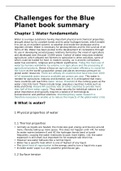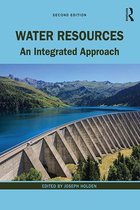Challenges for the Blue
Planet book summary
Chapter 1 Water fundamentals
Water is a unique substance having important physical and chemical properties,
brought about by its covalent bonds and its polar hydrogen bonds, which enable
it to act as an excellent solvent, to weather and erode the landscape and to
regulate climate. Water is necessary for photosynthesis and for the survival of all
forms of life. Water has been pivotal to the development of civilizations through
its use in developing societal power relations formed by the onset of agriculture
and developed over the past 13,000 years. Control of water resources enabled
agriculture, which allowed non-farmers to specialize in other activities, some of
which could be traded for food. In modern society, as in ancient civilizations,
water has economic, religious and symbolic significance. Today the main use of
water by humans worldwide, by volume, is in agriculture and the processing of
agricultural products. Hence a focus on agricultural water efficiency is crucial for
the future as the world’s population grows and places enormous pressure on
global water resources. There are already 45 countries that have less than 1000
m3 of renewable water resource available per person per year. This water is
needed for agriculture, industry and domestic use. It is anticipated that many
more countries will reach this water ‘stress’ threshold in the coming years as the
water crisis hits hard. These include large, populous countries in Asia such as
India and China. Around 44 countries rely on other countries to provide more
than half of their water supply. Thus water security for individual nations is of
great importance and typically requires a balance of technological,
socioeconomic and political solutions. Interdisciplinary water research is
therefore necessary to enable us to reduce the impacts of the global water crisis.
B What is water?
1 Physical properties of water
1.1 Thermal properties
• normally as liquids are heated, the molecules gain energy and bounce around
more, thereby taking up more space. This does not happen until >4C for water.
As water warms between 0 and 4C the hydrogen bonds bend or break
frequently, causing the water molecules to pack more tightly. >4C the water
expansion is still small, but important for for example sea level rise.
• However sea water behaves like a normal liquid.
• Water has a specific heat which is one of highest of any liquid.
• The latent heat of vaporization is the energy used to turn a liquid into a gas.
• Invisible water vapor is a very powerful greenhouse gas.
1.2 Surface tension
,• Within the main volume of a liquid, molecules are attracted in all directions by
their neighbors. However at the surface of a liquid there are no molecules
outside and so the molecules are only pulled inward. This has the effect of
forcing the liquid to adopt the minimum surface area, which is a spherical
shape.
• If the adhesive force between the liquid and solid exceeds that of the liquid’s
cohesive force, the liquid wets the surface.
• Adding a detergent to water makes the water reduce its surface tensions and
therefore allows a substance to be wetted by spreading water.
• Capillary action is the attractive forces of liquid that result in a phenomenon
whereby liquids flow within narrow gaps between solid material. It means that
water can flow upward.
2 Chemical properties of water
• The charges within water are very strong.
• A substance will dissolve in water if its molecules can interact with charged
molecules.
C Water and its importance for life
- Water is important for all organisms on earth.
D Water’s role in society
1 The development of civilizations
• Agriculture involves cultivating plants and herding animals. Both underwent
domestication in most cases, indicating the humans have taken control of the
reproduction of the individual plants and animals concerned. This is over the
last 13000 years.
• Civilizations were all found on their access to water. For more stability for their
farming and be less reliant on rainfall variations from year to year.
2 Contemporary society
• Today control of water provides an economic advantage that enables food
production, industry, navigation and sustenance for the population.
• Water has a cultural significance, for example in religion, recreation.
• Water is seen to be useful for environmental conservation.
• EU Water Framework Directive: states to improve the status of water bodies —
> ecological status, and for society.
E Global water resources
, 1 The amount of water available
• Severe water scarcity
2 Increasing demand for water use and consumption
• Consumptive water use: water is withdrawn and then not returned to the
resource that provided it.
• 5 key ways of increasing water efficiency for global agriculture: - focus efforts
in areas with currently low agricultural yields —> Breeding for resistance to
disease, pests and salinity and boosting harvest index for crops will help with
water efficiency.- improve soil fertility in arid and semi-arid areas —> In (semi)-
arid regions improvements in soil fertility can help water efficiency, because
lack of nutrients limits plant growth.- use trade to manage water efficiency-
reduce evaporation —> Globally by growing corps in places where climate and
management practices enable high water efficiency and trading them to places
with lower water efficiency. This reduces evaporation, and increases
transpiration which can increase water efficiency.- use biotechnology
• In developed countries water use is mostly for industrial use, for low and mid-
income countries it is mostly for agricultural use.
• In many developed countries agricultural management is well adapted to local
conditions and water use is relatively efficient.
•
Chapter 6 Aquatic ecosystems
This chapter has provided an introduction to some of the diverse habitats and
biotic groups that can be found in rivers and lakes, and the differences between
these two types of freshwater system. The trophic roles of various organisms
have been considered, and the chapter has explored how freshwater ecosystem
structure can be considered holistically through the study of food webs. The main
functional processes that are studied in freshwater systems, namely primary
production, secondary production, community respiration and nutrient cycling,
have been explored. Some of the key methods used by aquatic scientists to study
these processes have been outlined, and a consideration of the ecosystem
services that these processes provide to humans has been introduced. The later
sections of the chapter have provided overviews of some of the main ways in
which human activities have led to the modification of aquatic ecosystems. It is
important to remember that rivers and lakes are particularly diverse and well-
studied ecosystems. The ideas discussed herein for the most part provide only
introductions to general frameworks or ideas, rather than in depth blueprints for
how individual river or lake systems can be expected to work. The reader is
encouraged to consult the recommended. Further reading and key research
papers/references to build up a more detailed understanding and knowledge of
freshwater ecosystems.
• Lotic: running water systems of any size (in stead of river)
• Spatial units (hierarchical organization) for nested river ecosystem
geomorphological units: whole catchment, river segments, river reaches,
mesohabitats and patches (or microhabitats).
• Lentic: lakes and ponds, that move much slower than rivers and are considered
as still or standing bodies of water.
• Endemic: species that found nowhere else on the planet.






